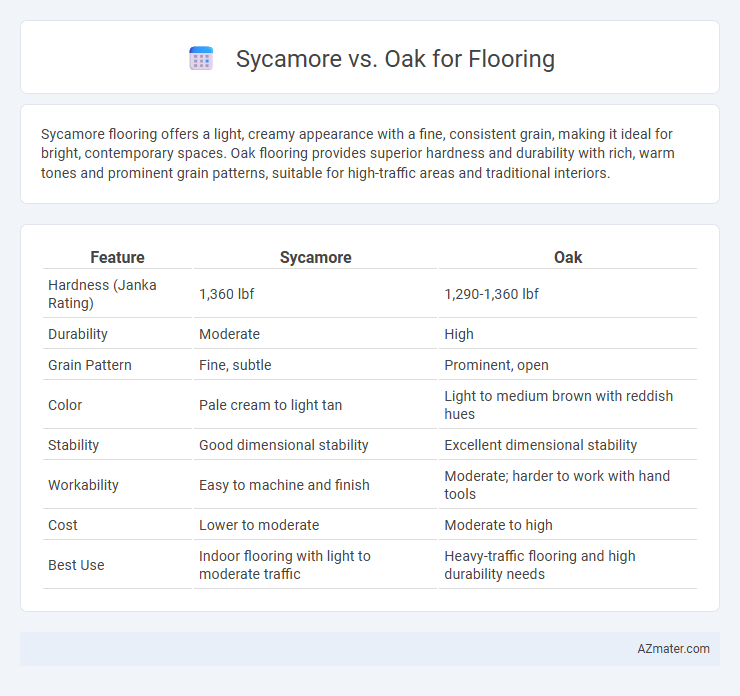Sycamore flooring offers a light, creamy appearance with a fine, consistent grain, making it ideal for bright, contemporary spaces. Oak flooring provides superior hardness and durability with rich, warm tones and prominent grain patterns, suitable for high-traffic areas and traditional interiors.
Table of Comparison
| Feature | Sycamore | Oak |
|---|---|---|
| Hardness (Janka Rating) | 1,360 lbf | 1,290-1,360 lbf |
| Durability | Moderate | High |
| Grain Pattern | Fine, subtle | Prominent, open |
| Color | Pale cream to light tan | Light to medium brown with reddish hues |
| Stability | Good dimensional stability | Excellent dimensional stability |
| Workability | Easy to machine and finish | Moderate; harder to work with hand tools |
| Cost | Lower to moderate | Moderate to high |
| Best Use | Indoor flooring with light to moderate traffic | Heavy-traffic flooring and high durability needs |
Introduction to Sycamore and Oak Flooring
Sycamore flooring offers a creamy white to light tan color with subtle grain patterns, providing a bright and clean aesthetic ideal for modern and traditional interiors. Oak flooring, available in red and white varieties, features pronounced grain patterns and warm hues ranging from light brown to reddish tones, renowned for its durability and classic appeal. Both woods are hardwood options favored for flooring due to their strength, wear resistance, and ability to be sanded and refinished multiple times.
Wood Characteristics: Sycamore vs Oak
Sycamore wood features a fine, consistent grain with a pale, creamy color that lightens interior spaces and offers a smooth texture ideal for flooring. Oak wood, known for its prominent grain patterns and durability, presents a warm, reddish-brown to golden hue, providing a classic and robust flooring option. Both woods exhibit strong hardness, with Oak generally ranking higher on the Janka hardness scale, contributing to superior resistance against dents and wear in high-traffic areas.
Appearance and Grain Patterns
Sycamore flooring features a light, creamy color with subtle, wavy grain patterns that create a smooth and elegant appearance, making it ideal for contemporary and minimalist interiors. Oak flooring presents a more pronounced grain with distinct rays and knots, offering a rich texture and warm, natural tones that suit traditional and rustic designs. The contrast between sycamore's refined uniformity and oak's bold, varied grain allows homeowners to select flooring that aligns closely with their aesthetic preferences.
Durability and Hardness Comparison
Sycamore flooring offers moderate durability with a Janka hardness rating of approximately 1,440, making it suitable for residential areas with moderate traffic. Oak flooring, typically red or white oak, boasts higher durability and hardness, with Janka ratings around 1,290 for red oak and 1,360 for white oak, providing better resistance to dents and wear. Oak's denser grain structure enhances its longevity in high-traffic environments compared to the softer, more porous sycamore wood.
Cost and Affordability
Sycamore flooring typically costs between $3 to $6 per square foot, making it a more budget-friendly option compared to oak, which ranges from $5 to $10 per square foot. The lower price of sycamore is due to its faster growth and wider availability, offering an affordable alternative without sacrificing durability. Oak flooring, while pricier, provides greater long-term value through enhanced hardness and resistance to wear, justifying the initial investment for high-traffic areas.
Installation: Sycamore vs Oak Flooring
Sycamore flooring offers easier installation due to its lighter weight and consistent grain pattern, allowing for smoother cutting and fitting. Oak flooring, while more durable, often requires more precise handling and acclimation time to prevent expansion and contraction issues. Both woods benefit from professional installation to ensure longevity and optimal aesthetic appeal.
Maintenance and Care Requirements
Sycamore flooring demands regular sealing and moderate moisture control to prevent warping and maintain its smooth surface, while oak flooring is highly durable and more resistant to scratches, requiring less frequent refinishing. Oak's open grain pattern can trap dirt, necessitating routine sweeping and occasional deep cleaning, whereas sycamore's tighter grain makes it easier to wipe clean but more sensitive to prolonged exposure to water. Both woods benefit from using protective pads under furniture and avoiding harsh chemicals to prolong their lifespan and preserve their natural beauty.
Environmental Impact and Sustainability
Sycamore flooring is valued for its rapid growth rate, making it a more renewable resource compared to oak, which matures much slower. Oak, although denser and often more durable, typically involves longer harvesting cycles, contributing to higher environmental strain. Choosing sycamore supports sustainable forestry practices by reducing habitat disruption and carbon footprint due to its quicker replenishment.
Best Uses & Room Recommendations
Sycamore flooring offers a light, consistent grain ideal for contemporary and minimalist interiors, making it perfect for living rooms, kitchens, and bedrooms that require a bright, clean look. Oak flooring, known for its durability and distinctive grain patterns, excels in high-traffic areas such as hallways, dining rooms, and commercial spaces due to its resilience and classic appeal. Sycamore suits spaces where subtle elegance is desired, while oak is preferred for rooms needing robust wear resistance and timeless style.
Sycamore vs Oak Flooring: Pros and Cons
Sycamore flooring offers a lighter, uniform grain pattern that brightens interiors and resists wear, making it ideal for modern, airy spaces. Oak flooring, known for its durability and classic, prominent grain, provides a warm, traditional aesthetic suitable for high-traffic areas. Sycamore's softer hardness rating makes it more prone to dents compared to the harder, more resilient oak, but it is easier to sand and refinish.

Infographic: Sycamore vs Oak for Flooring
 azmater.com
azmater.com